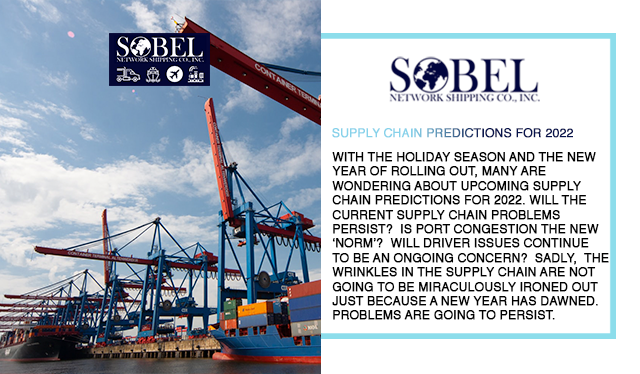With the holiday season and the new year of rolling out, many are wondering about upcoming supply chain predictions for 2022. Will the current supply chain problems persist? Is port congestion the new ‘norm’? Will driver issues continue to be an ongoing concern? Sadly, the wrinkles in the supply chain are not going to be miraculously ironed out just because a new year has dawned. Problems are going to persist.
Truck Issues
In 2022, the use of electric trucks is going to become an even more significant part of 2022. However, with the shortage of semiconductors, the automotive industry’s ability to produce vehicles will continue to be a nightmare.
Autonomous trucks (driverless) are being examined and mapped for future use, but at this time, there remains a multitude of concerns over safety and other problems.
Driver Problems
Worker classification might get pushed into 2023, and if it does not, then problems are sure to arise. Many are debating whether or not California’s AB5 independent contractor law applies to truckers. For two years, an injunction has blocked it from being implemented. The California Trucking Association continues to await a decision by the solicitor general, but with no deadline as to when SCOTUS has to rule, there is no way to know the impact in the coming year. Many say that the ruling will not come until October.
Other significant developments include the Biden administration’s proposal for a rule defining independent contractors. The rule will undoubtedly impact the Wage and Hour Division of the Department of Labor.
Another contractor and driver development are on the ballot in Massachusetts in November when the state will decide whether to implement its version of the controversial California referendum, Prop 22.
Finance Issues
The volume will continue to be up, but historically, low inventories are a problem and will continue into the second quarter.
Without government stimulus, rates are going to increase, and driver demographics and extended delivery schedules remain at capacity.
Rate increases are supposed to offset the cost of inflammation. There are a lot of unknowns, and a lot will hinge on whether or not consumer spending softens. Many experts project a cycle downturn during the second half of the year.
Carriers have made record profits and cash generation, enabling them to add new drivers and equipment to their businesses. However, those profits might not be as lucrative in 2022.
Legislation and Regulations
It’s hard to know the figure of the Infrastructure Investment and Jobs Act will be for 2022. Many are skeptical about if it passes whether the money included in the bill can be disbursed fast enough to ‘fix’ or unclog the bottlenecks that have occurred in the supply chain.
The Ocean Shipping Reform Act, if passed, will place more restrictions on international ocean careers, which will cost shippers.
Final Mile
Ecommerce volume and demand will continue to rise, and so will the need for faster and efficient parcel fulfillment and delivery services. UPS and FedEx will discard big shippers if they cannot meet the pricing lines. Capacity is going to expand but will it meet the burgeoning demand of the volume? The answer to that question remains to be seen. A higher volume level could mean shipping price reductions.
The U.S. Postal Service wants to offer a more substantial parcel delivery presence in the new year, but shippers often lack confidence in the Postal Service.
Maritime
COVID will continue to impact ocean shipping, especially as China adheres to their zero COVID policy the China exports are in peril.
The potential for the US to change its regulation on ocean carriers might also impact ocean transportation. Also, the disputes with Russia, China, and Iran are all going to cause continued turmoil.
Air Cargo
The growth of air cargo is going to continue throughout 2022. With the continued surge in e-commerce, the need for new freighters will remain constant.
Railroad
The Surface Transportation Board, is set to discuss several issues over the next year. Many of the topics include railroad company mergers and their impact on communities.
Borders
With the global economy struggling to recover from COVID19, many companies are considering relocating from Asia to nearby Mexico. Nearshoring operations might start to become a reality in for many in the next year.
Newe regulations known as the carta porte, are also occurring which will reduce cargo theft. Many are concerned it might add unwanted additional paperwork though.
Canada recently signed a $700 billion cross border trade agreement with the U.S. which will push prices up.
Changes to the supply chain are going to occur over the the coming year. Many hope for the best but others foresee more difficulties.


